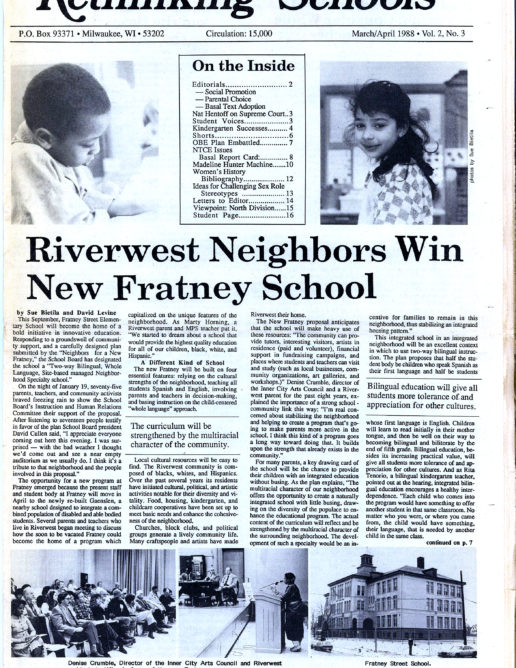Social Promotion and the Basal Reader
Social promotion, the practice of passing children on to the next grade level even if they are functioning significantly below grade level academically, came under sharp criticism several years ago. Now, with continuing problems of high dropout rates and low academic performance in the middle and high schools, many people are wondering if all the talk of stopping social promotion by school leaders was anything more than just talk.
A recent school board resolution called for a full report on the status of social promotion in the Milwaukee Schools.
We know it is not a simple issue. But we do feel that it would bode well for those who want to seriously examine social promotion and the reasons so many students are entering middle and high school as “at risk students,’’ to take a serious look at our method of reading instruction: the basal reader.
In the National Council of Teachers of English recent “Report Card on the Basal Reader” (which is reviewed elsewhere in this issue) the authors state that “in many American schools promotion from one grade to another is largely based on success or failure in the basals….[T]his absolute dominance of the basal reader…makes it essential that its nature and use be examined critically at this time.”
We agree.
In Milwaukee the promotion of most elementary school children is tied to their scores on the end of book tests in the basal reader system. While these tests may assess whether or not students can answer multiple choice questions about minute skills, it is doubtful they adequately assess reading comprehension and they definitely do not assess whether or not the student actually reads or wants to read.
Moreover, there is a great deal of pressure on classroom teachers to make sure their students are “functioning on level” or, at worst, a semester below so that the students can move on to the next grade. Teachers are encouraged by some supervisors to emphasize the skills that are covered in the tests. Failing students are pushed through a full semester of reading in a short six weeks of half-day summer school.
Thus even though students may officially be “on level” by the time they get to the intermediate grades, many are actually functioning significantly “below level” in reading.
This is a deceptive way of analyzing progress in reading ability, and for many students it is camouflaging and, in fact, creating serious reading problems. Having had reading defined for years by a sterile basal program, intermediate students usually show little understanding of the purposes of reading or various independent and personal strategies for approaching printed material. As they are put into more difficult basal texts and are forced to deal with increasingly difficult content textbooks, frustration mounts and interest in reading further declines. Those students who don’t succeed in reading usually get more of the same — skill drill, practice and worksheets. Ironically, the harder we push this basal type instruction, the more we are setting the groundwork for the future failure of our children.
There is no reason our children need to start down this road to failure in the first place. Many teachers have developed innovative ways to teach reading in the context of the real world and a variety of subject areas. The article by Rita Tenorio in this issue describes such approaches in a number of kindergarten classes in the Milwaukee Public Schools. Such innovations in reading and language arts instruction, often called the whole language approach, should be encouraged through all grade levels.
The School Board’s call for a report on social promotion comes the same year the Board will act on the proposed reading basal textbook adoption.
It is our hope the Board will grasp how the basal reading system has contributed to the creation of “at-risk students” and has finessed the problems of social promotion.

